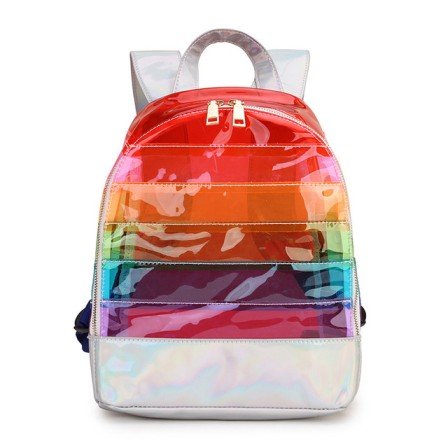
I. Introduction
Clear backpacks may seem like a practical solution for safety and convenience, but their impact on the environment must be taken into account. The production of these bags often involves the use of plastic materials, which can cause harm to the environment through pollution and depletion of natural resources. The manufacturing process can also generate waste and byproducts, which need to be properly disposed of. Additionally, the use of clear backpacks can encourage a culture of disposability, contributing to more waste and frequent replacements. It’s important to consider the lifecycle of a product and its environmental impact on our choices.
What’s more, if they are not disposed of in a responsible manner, they can add to the pollution and waste in our landfills. This is not only detrimental to the environment, but to the wildlife that calls it home as well.
II. Manufacturing Process
A. Material selection and sourcing
The eco-friendliness of clear backpacks relies heavily on the selection and sourcing of their materials. The traditional plastics used in their construction, like PVC and vinyl, are problematic for the environment, being derived from non-renewable sources and unable to biodegrade. To make a positive impact, backpack manufacturers can turn to options like eco-friendly or recycled plastics and bioplastics, made from renewable resources. Durable materials that stave off the need for frequent replacements are another easy way to reduce waste generation.

B. Manufacturing process and energy consumption
Clear backpacks don’t just impact what’s in them — their manufacturing process can also have a significant impact on the environment. From material preparation to finishing touches, production can require a lot of energy. This energy consumption contributes to greenhouse gas emissions and ultimately, climate change. Thankfully, some manufacturers are implementing energy-efficient technologies like LED lighting or switching to renewable sources like solar or wind power to reduce their environmental impact.
By optimizing production processes to reduce waste and prioritizing sustainable manufacturing practices, they can lower material costs, save energy, and improve production efficiency. This can be achieved by implementing practices such as using non-toxic and water-based dyes, reducing the use of harmful chemicals, and implementing waste reduction programs. By making these changes, manufacturers can contribute to a more sustainable future and make a difference in minimizing their environmental impact.
C. Waste and byproduct management
When it comes to producing clear backpacks, the process can unfortunately result in waste and byproducts that can harm the environment if not handled correctly. These negative impacts can include excessive materials, harmful chemicals, and wastewater.
However, there is hope – manufacturers can make a difference by implementing eco-friendly practices such as recycling, reusing, and repurposing. This way, leftover scraps and materials can be given a new life and a second chance at reducing the carbon footprint left behind.
From proper wastewater treatment to sustainable chemical management, these efforts can reduce their environmental impact and lead the way for a more sustainable future. With a focus on waste reduction and responsible byproduct management, manufacturers can take a proactive step towards protecting the planet.
III. Use and Disposal

A. Durability and lifespan
When it comes to sustainability, clear backpacks made from non-biodegradable plastic materials can be a major contributor to waste and pollution. But there’s a simple solution: durability. By focusing on making clear backpacks that are built to last, manufacturers can reduce the need for constant replacements and help keep the environment clean.
Manufacturers are now implementing repair and maintenance programs to ensure that your backpack stays functional for longer. From patching holes to replacing zippers, these programs offer a sustainable solution by reducing waste and minimizing the need for frequent replacements. By prioritizing durability and longevity, manufacturers are not only benefiting customers but also contributing to a more environmentally friendly future.
B. Recycling and waste management
Protecting our environment is crucial, especially when it comes to the sustainability of clear backpacks. These types of backpacks are usually made from plastic materials, which can create waste and pollution. But there are ways to tackle this issue by embracing recycling. To reduce the need for virgin plastic, clear backpack manufacturers can prioritize the use of recycled plastic in their products. To take things a step further, recycling programs can be put in place to encourage customers to recycle their clear backpacks when they reach the end of their life.
Additionally, they can dispose of hazardous waste responsibly to prevent environmental harm. When we prioritize recycling and waste disposal, we open the door to a more sustainable future. Clear backpack manufacturers can lead the charge by promoting eco-friendliness and encouraging customers to recycle their backpacks when they are no longer needed.
IV. Alternatives to Clear Backpacks

A. Alternative bag options for schools and events
There are several alternative bag options that schools and events can consider to reduce their environmental impact while still meeting their needs.
- Reusable tote bags: Reusable tote bags are a sustainable and eco-friendly option that can be used for a variety of purposes. They are durable, easy to clean, and can be customized with different designs and logos.
- Backpacks made from sustainable materials: Backpacks made from sustainable materials such as organic cotton, recycled polyester, or hemp can be a great option for schools and events. These materials are biodegradable or have a lower environmental impact than traditional plastics.
- Paper bags: For events or occasions where a disposable option is necessary, paper bags can be a good alternative to plastic bags. Paper bags are biodegradable and can be easily recycled or composted.
- Upcycled bags: Upcycled bags are made from repurposed materials such as old clothing, banners, or seat belts. They are unique, sustainable, and can be customized with different designs and colors.
- Canvas bags: Canvas bags are a durable and sustainable option that can be used for a variety of purposes. They are easy to clean, reusable, and can be customized with different designs and logos.
B. Future considerations for sustainable backpacks

As the importance of sustainability continues to grow, there are several future considerations for sustainable backpacks that manufacturers and consumers can take into account:
- Innovative materials: Manufacturers can explore and invest in new materials that are more sustainable and environmentally friendly, such as bioplastics or plant-based materials. These materials can offer similar properties to traditional plastics but with a lower environmental impact.
- Circular economy: The adoption of circular economy principles, such as designing for disassembly and recycling, can help reduce waste and prolong the lifespan of products. By designing backpacks with the intention of easy disassembly and repair, manufacturers can reduce waste and promote sustainable practices.
- Sustainable production processes: Manufacturers can invest in sustainable production processes that minimize waste and energy consumption. This can include the use of renewable energy sources, efficient water management practices, and responsible waste management.
- Consumer education: Consumers can play a crucial role in promoting sustainability by choosing products with sustainable materials and production processes, and properly disposing of them at the end of their useful life. Educating consumers on the importance of sustainability and providing clear information on the environmental impact of different products can help promote sustainable choices.
V. Conclusion
In conclusion, while clear backpacks have become a popular and convenient option for schools and events, they can also have significant environmental impacts. From the production process to disposal, clear backpacks can contribute to the accumulation of plastic waste in our ecosystems. However, by taking a sustainability-focused approach to the manufacturing and use of clear backpacks, we can work towards reducing their environmental impact. This can include the use of sustainable materials, responsible manufacturing practices, and prioritizing waste reduction and recycling programs. As consumers, we can also play a crucial role in promoting sustainability by making conscious choices and properly disposing of our backpacks at the end of their useful life. By considering these factors, we can work towards a more sustainable future and reduce the environmental impact of clear backpacks.
Our company’s commitment to the environment is evident in every step of our production process. From carefully selecting raw materials to minimizing pollution, we are doing our part to protect our planet. Interested in purchasing wholesale transparent backpacks? Fill out the form to the right to connect with us now!


